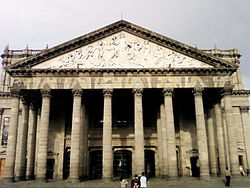- Teatro Degollado
-
Teatro Degollado (Degollado Theater) is a neoclassical[1] Mexican theater known for its diverse performances and artistic design. It is located on a downtown plaza on the street Belen between Hidalgo Avenue and Morelos Avenue in the city of Guadalajara, Jalisco. Many performances (from cultural Mexican dances to international operas) take place at this building.[2] Meant to be a monument of Guadalajara's culture, the theater was inaugurated on September 1866; breathing life through its innovating artistic beauty.Contents
Original Idea
Degollado Theater came to be as a result of Mexico's 1800's theatrical movement. There was a high demand for a great theater in Guadalajara, Jalisco that displayed the cultural arts of the city.[2] In response to the demand, on October 1, 1855, Antonio Perez Verdia proposed the construction of Alarcon Theater (after the classic dramatist Juan Ruiz de Alarcon)[3] to the current governor of the time, Santos Degollado. By December 12 of that same year, Degollado signed the official decree to build the structure, and by March, 1856, Degollado set the first cornerstone of the building. Coming April 1856, Jacobo Galvez was appointed to lead the initial construction of the theater.[1][4]
Due to a three year war in Mexico, and the change of government within the dispute, the completion of the project was slow. On November 12, 1861, Governor Pedro Amazon decided to change the proposed name of the project from "Alarcon Theater" to "Degollado Theater", after ex-governor and general at the time of his dead, Santos Degollado (killed in a battle on June 16, 1861).[1][2][3] This change of name was not acknowledged at the time of inauguration until December 18, 1866, when Mexican liberal troops regained control of the plaza where the theater is located.[4]
First Inauguration
The theater's first inauguration was on September 13, 1866, with the opera "Lucia di Lammermoor", performed by Angela Peralta, opera soprano noted as the "Mexican Nightingale".[1][3] At this point in time the theater was not completed which led to many renovations and 4 more inaugurations.[4]
Inauguration Dates
These are the dates of all the inaugurations following renovations of the structure:
- September 13, 1866
- October 30, 1880
- September 15, 1910
- June 28, 1941
- September 8, 1964
Artistic Design
Degollado Theater is famous for its beautiful paintings along its golden walls on the interior of the building and its symbolic mosaic on the exterior.
Interior
Most of the theater's renovations have been so to improve the interior design by adding paintings and giving it its current red and golden color. Before the theater's first inauguration, Gerardo Suarez and Carlos Villasenor decorated the theater with a mural representing Dante Alighieri's forth song in the Divine Comedy.[2] On 1877, Fermin Riestra was ordered to continue with the construction of the building; a three year process on which a gilded eagle holding a Mexican flag on its talons and a chain on its beak was placed on the center of the inner arch of the building. Within the three year construction, Felipe Castro painted the murals Time and Hours and The Fame on the proscenium arch. Between 1980 and 1990, the stucco on the concert hall was completed and a golden color was added to the interior walls. By 1893, tiles were removed from the stage, due to the lack of support they provided for the structure, and were replaced by a metal arch on 1905. Between 1909 and 1910 artist Roberto Montenegro focused on the reconstruction and decoration of the interior of the building which included the addition of a crystal lamp on the theater's vault. Fifty years later, architect Ignacio Diaz Morales was in charge of a complete restoration of the building where sculptures by Benito Castaneda replaced Venetian mosaics. On May 2001, a chamber hall that can hold 200 people was added to the inside of the building.[1][4]
Exterior
With fewer renovations than the interior, the exterior of the building still holds its artistic recognition. Between 1953 and 1959 Montenegro painted the mosaic of Apollo and the nine muses on the pediment of the theater. The portico supporting the pediment consists of 16 Corinthian columns.[1][3] While Ignacio Diaz was in charge of the renovation of the theater, he ordered the engraving of the phrase "May we never get the rumor of discord" along Montenegro's mosaic on the main entrance.[2]
Building's dimensions
Several measurements of the Theater:
- Building measures 97 m long, 36.4 m wide, and 22.5 mts high.
- Stage measures 54 meters by 18 meters.[1]
- Oval hall measures 10 × 6.5 mts. wide.
- Building capacity of 1,015 spectators.[1]
References
- ^ a b c d e f g h " Guadalajara Historic District Teatro Degollado ", "gDLtours".
- ^ a b c d e f “Teatro Degollado”, "Discover Mexico Adventures".
- ^ a b c d "Teatro Degollado", "Costa Alegre & Mexico Practical Travel Guide", Tuesday July 06, 2008.
- ^ a b c d e Pizano y Saucedo, Carlos. "Centenario del “Teatro Degollado” De Guadalajara", "El Colegio de México", Guadalajara.
Categories:- Opera houses in Mexico
Wikimedia Foundation. 2010.

